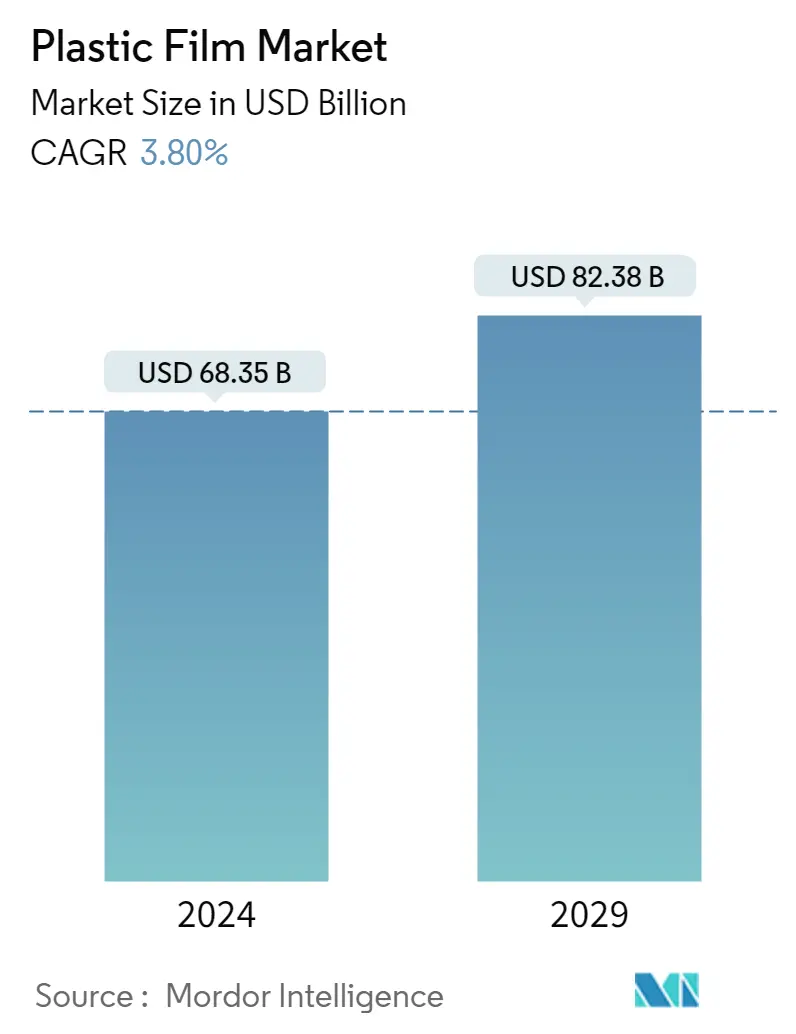Market Size of Plastic Film Industry

| Study Period | 2019 - 2029 |
| Market Size (2024) | USD 68.35 Billion |
| Market Size (2029) | USD 82.38 Billion |
| CAGR (2024 - 2029) | 3.80 % |
| Fastest Growing Market | Asia Pacific |
| Largest Market | North America |
Major Players
*Disclaimer: Major Players sorted in no particular order |
Plastic Films Market Analysis
The Plastic Film Market size is estimated at USD 68.35 billion in 2024, and is expected to reach USD 82.38 billion by 2029, growing at a CAGR of 3.80% during the forecast period (2024-2029).
Data from a Harris Poll commissioned by Flexible Packaging indicates that 83% of brand owners presently use flexible packaging. This encourages the market to grow.
- Over the past few years, the packaged food and beverage industry has seen substantial expansion on a global scale. The packaged food sector is being driven by several macro factors, including evolving lifestyles, an increase in the urban population, increased economic activity in emerging markets, and greater penetration of e-retail globally. Plastic films offer several advantages over other rigid packaging materials as they are lightweight, provide good barrier properties, and, most importantly, are recyclable and reusable.
- Further, the steady demand for quick, healthy breakfast products is projected to increase the market growth of HDPE films. HDPE films have moisture barrier properties, making them suitable for packaging breakfast cereals, especially flakes. Additionally, with rising e-commerce, there is substantial growth for protective packaging, including plastic films, wraps, etc. This trend is expected to support the development of the market in the future.
- However, the rising stringent regulations against plastic recyclability are expected to hinder market growth in the future. Substitutes available in the market can hamper the development of the market. There are numerous governmental as well as non-governmental organizations in the UK and the US that are engaged in supporting the ban on the use of plastic in packaging and non-packaging industries. In the US, several governmental and non-governmental organizations are also involved in discouraging the usage of plastic sheets and films in packaging organic produce.
- Growth in the business is primarily driven by the growing scale of key application industries, such as food and beverage, pharmaceuticals, personal and household care, and the increasing penetration of organized e-retail globally.
- The COVID-19 pandemic has led the industrial and manufacturing sectors into an unknown operating environment globally. Government restrictions on the number of people that can gather in one place severely impacted the sectors. For example, the manufacturing industry was highly hit by the impact of the virus. The production and factory operations in the automotive, metal processing, oil and gas, electronics, and aerospace industries were temporarily shut down during the lockdown period.
- Most enterprises are dependent on China for raw material supply. Hence, supply chain disruptions also have had a significant impact on industrial output. The global economy had contracted due to the pandemic.
Plastic Films Industry Segmentation
Plastic film is defined as a continuous form of plastic material that is thin and usually wound on a core or cut into sheets. The study tracks the demand for plastic films through revenue accrued from the sale of these films offered by various vendors. This study is segmented by film types, such as PP films, BOPET films, PE films, PVC films, and other plastic film types, end-user Industries, and geographic regions, such as North America, Europe, Asia-Pacific, the Middle East and Africa, and Latin America. The market sizes and forecasts are provided in terms of value (USD billion) for all the above segments.
| PP Films Market | |||||||||||||||||||||||||||||
| |||||||||||||||||||||||||||||
| |||||||||||||||||||||||||||||
|
| BOPET Films Market | ||||||||||||||||||||||||||
| ||||||||||||||||||||||||||
| ||||||||||||||||||||||||||
|
| PE Films Market | |||||||||||||||||||||||
| |||||||||||||||||||||||
| |||||||||||||||||||||||
|
| PVC Films Market | ||||||||||||||||||||
| ||||||||||||||||||||
|
| Other Plastic Film Types | |
| Polystyrene (PS) | |
| Bio-Based Plastic Films | |
| Polyvinylidene Chloride (PVDC) | |
| Ethylene Vinyl Alcohol (EVOH) |
Plastic Film Market Size Summary
The plastic film market is poised for significant growth, driven by the increasing demand for flexible packaging solutions across various industries. The market is experiencing a surge in demand due to the expansion of the packaged food and beverage sector, which is influenced by changing lifestyles, urbanization, and the rise of e-retail. Plastic films are favored for their lightweight nature, excellent barrier properties, and recyclability, making them a preferred choice over rigid packaging materials. The food industry, as the largest end-user, is witnessing strong growth due to the rising demand for convenient packaging for ready-to-eat foods and the need for extended shelf life. The pharmaceutical sector also contributes to market expansion, particularly in regions like Europe and Asia-Pacific, where advancements in healthcare and increased awareness are driving demand for innovative packaging solutions.
The Asia-Pacific region is expected to lead the market's growth, supported by the burgeoning middle class in countries like China and India, which is boosting industries such as food and beverages, pharmaceuticals, and cosmetics. The region's growth is further fueled by the rise in disposable income, organized retailing, and export demands requiring superior packaging standards. Despite the promising growth prospects, the market faces challenges from stringent regulations on plastic use and the availability of substitutes. However, the competitive landscape remains dynamic, with global players engaging in partnerships, mergers, and acquisitions to maintain their market position. Innovations in packaging technologies, such as those developed by Sukano and Innovia Films, are also contributing to the market's evolution, enhancing the functionality and sustainability of plastic films.
Plastic Film Market Size - Table of Contents
-
1. MARKET SEGMENTATION
-
1.1 PP Films Market
-
1.1.1 By Type
-
1.1.1.1 BOPP
-
1.1.1.2 CPP
-
-
1.1.2 By End-user Industry
-
1.1.2.1 Food
-
1.1.2.2 Beverage
-
1.1.2.3 Pharmaceuticals
-
1.1.2.4 Industrial
-
1.1.2.5 Other End-user Industries
-
-
1.1.3 By Geography
-
1.1.3.1 North America
-
1.1.3.1.1 United States
-
1.1.3.1.2 Canada
-
-
1.1.3.2 Europe
-
1.1.3.2.1 United Kingdom
-
1.1.3.2.2 Germany
-
1.1.3.2.3 France
-
1.1.3.2.4 Italy
-
1.1.3.2.5 Spain
-
1.1.3.2.6 Poland
-
1.1.3.2.7 Benelux
-
1.1.3.2.8 Rest of Europe
-
-
1.1.3.3 Asia-Pacific
-
1.1.3.3.1 China
-
1.1.3.3.2 India
-
1.1.3.3.3 Japan
-
1.1.3.3.4 Rest of Asia-Pacific
-
-
1.1.3.4 Latin America
-
1.1.3.4.1 Brazil
-
1.1.3.4.2 Argentina
-
1.1.3.4.3 Mexico
-
1.1.3.4.4 Rest of Latin America
-
-
1.1.3.5 Middle East and Africa
-
-
-
1.2 BOPET Films Market
-
1.2.1 By Type
-
1.2.1.1 Thin BOPET
-
1.2.1.2 Thick BOPET
-
-
1.2.2 By End-user Industry
-
1.2.2.1 Packaging and Metallizing
-
1.2.2.1.1 Food and Beverage
-
1.2.2.1.2 Pharmaceuticals
-
1.2.2.1.3 Personal Care
-
1.2.2.1.4 Other End-user Industries
-
-
-
1.2.3 By Geography
-
1.2.3.1 North America
-
1.2.3.1.1 United States
-
1.2.3.1.2 Canada
-
-
1.2.3.2 Europe
-
1.2.3.2.1 United Kingdom
-
1.2.3.2.2 Germany
-
1.2.3.2.3 France
-
1.2.3.2.4 Italy
-
1.2.3.2.5 Spain
-
1.2.3.2.6 Poland
-
1.2.3.2.7 Rest of Europe
-
-
1.2.3.3 Asia-Pacific
-
1.2.3.3.1 China
-
1.2.3.3.2 India
-
1.2.3.3.3 Japan
-
1.2.3.3.4 South Korea
-
1.2.3.3.5 Thailand
-
1.2.3.3.6 Indonesia
-
1.2.3.3.7 Rest of Asia-Pacific
-
-
1.2.3.4 Latin America
-
1.2.3.5 Middle East and Africa
-
-
-
1.3 PE Films Market
-
1.3.1 By Material
-
1.3.1.1 LDPE
-
1.3.1.2 HDPE
-
-
1.3.2 By End-user Industry
-
1.3.2.1 Food
-
1.3.2.2 Beverage
-
1.3.2.3 Agriculture
-
1.3.2.4 Construction
-
1.3.2.5 Other End-user Industries
-
-
1.3.3 By Geography
-
1.3.3.1 North America
-
1.3.3.1.1 United States
-
1.3.3.1.2 Canada
-
-
1.3.3.2 Europe
-
1.3.3.2.1 United Kingdom
-
1.3.3.2.2 Germany
-
1.3.3.2.3 France
-
1.3.3.2.4 Italy
-
1.3.3.2.5 Spain
-
1.3.3.2.6 Rest of Europe
-
-
1.3.3.3 Asia-Pacific
-
1.3.3.3.1 China
-
1.3.3.3.2 India
-
1.3.3.3.3 Japan
-
1.3.3.3.4 South Korea
-
1.3.3.3.5 Rest of Asia-Pacific
-
-
1.3.3.4 Latin America
-
1.3.3.5 Middle East and Africa
-
-
-
1.4 PVC Films Market
-
1.4.1 By End-user Industry
-
1.4.1.1 Food and Beverage
-
1.4.1.2 Pharmaceuticals
-
1.4.1.3 Electrical/Electronics
-
1.4.1.4 Other End-user Industries
-
-
1.4.2 By Geography
-
1.4.2.1 North America
-
1.4.2.1.1 United States
-
1.4.2.1.2 Canada
-
-
1.4.2.2 Europe
-
1.4.2.2.1 United Kingdom
-
1.4.2.2.2 Germany
-
1.4.2.2.3 France
-
1.4.2.2.4 Rest of Europe
-
-
1.4.2.3 Asia-Pacific
-
1.4.2.3.1 China
-
1.4.2.3.2 India
-
1.4.2.3.3 Japan
-
1.4.2.3.4 Rest of Asia-Pacific
-
-
1.4.2.4 Latin America
-
1.4.2.5 Middle East and Africa
-
-
-
1.5 Other Plastic Film Types
-
1.5.1 Polystyrene (PS)
-
1.5.2 Bio-Based Plastic Films
-
1.5.3 Polyvinylidene Chloride (PVDC)
-
1.5.4 Ethylene Vinyl Alcohol (EVOH)
-
-
Plastic Film Market Size FAQs
How big is the Plastic Film Market?
The Plastic Film Market size is expected to reach USD 68.35 billion in 2024 and grow at a CAGR of 3.80% to reach USD 82.38 billion by 2029.
What is the current Plastic Film Market size?
In 2024, the Plastic Film Market size is expected to reach USD 68.35 billion.

